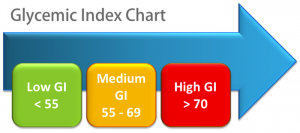What is the Glycemic Index?
 You have probably heard someone, somewhere talk about the glycemic index. If you are the average person, you most likely said to yourself, “the what?????” Well, I am going to give you a little more info on the the Glycemic Index (GI). The GI, developed in the 1980s as an alternative to the “simple vs complex” carbohydrate separation, is a scientific ranking of foods immediate effect on blood sugar levels. A carbohydrates GI is determined by measuring the 2 hour blood glucose response after consuming 50g of glucose. Many everyday carbohydrate based foods have been tested and ranked according to the rate that sugars are released into the bloodstream.
You have probably heard someone, somewhere talk about the glycemic index. If you are the average person, you most likely said to yourself, “the what?????” Well, I am going to give you a little more info on the the Glycemic Index (GI). The GI, developed in the 1980s as an alternative to the “simple vs complex” carbohydrate separation, is a scientific ranking of foods immediate effect on blood sugar levels. A carbohydrates GI is determined by measuring the 2 hour blood glucose response after consuming 50g of glucose. Many everyday carbohydrate based foods have been tested and ranked according to the rate that sugars are released into the bloodstream.
Which foods should you eat before and after exercise? (High GI foods or Low GI foods?)
Two hours before exercise, foods should be consumed with a low GI index. It is recommended that high GI foods be eaten within 1-2 hours after exercise.
Here are some examples of High GI foods:
Bread
Pretzels
Baked Potato
Rice Cakes
Rice Chips
Cereal
Pizza
Bagels
Raisins
Watermelon
Pineapple
Examples of Low GI foods:
Apple/ Kiwi/ Bananas
Apple juice/pineapple juice/carrot juice
Low fat yogurt
Skim milk
Peanuts
Legumes (beans & lentils)
Pasta
Vegetables

